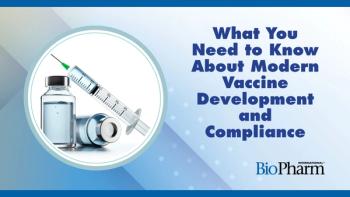
- BioPharm International-03-02-2013
- Volume 2013 Supplement
- Issue 1
Securing the Supply Chain
A Q&A with SAFC and BioReliance about sourcing and risk mitigation for raw materials.
In an industry where materials are globally sourced, qualifying the raw materials that go into producing a pharmaceutical product can be complex. Dave Backer, senior director and general manager at SAFC's Carlsbad, CA facility, and Mike Garrett, senior director, global marketing at BioReliance, spoke to BioPharm International about sourcing and risk mitigation for raw materials.
Photo Credit: Oxford/Getty Images
SOURCING RAW MATERIALS
BioPharm: It's now a global sourcing market for raw materials, presenting problems for manufacturers in ensuring a safe and secure supply chain. What industry initiatives are in place to ensure supply-chain quality?
Backer: SAFC is in the business of providing raw materials or services to the API market, both for small molecules and biologics. We recognize that there are two factors that have to be considered in the supply chain and for the raw materials that go into that supply chain. The first is: can the raw material be made correctly to begin with, and what does that mean? What is the level of quality of products that go into the supply chain? The reality is that some of these raw materials are made in large volumes for other industrial applications, of which the biologic or chemistry use is a small part of the total.
The second issue is where was it made? Determining where something is made is much more difficult than it sounds, and requires knowing, whatever that chemical is, that we've gone back to the source of manufacture and we've qualified that supplier. SAFC has initiated a program called PharmaGrade. It's a portfolio of products where we say that, for these products, we will confirm that we know exactly who the manufacturer is, that we've done quality audits, and that it's made appropriately for pharmaceutical manufacturing. There are other companies that are doing the same. EMD Millipore, for example, has the Emprove program, and some other companies are going down that path as well. For us as an industry, as suppliers, it becomes more evident that we have to hit a certain bar. Pharmaceutical and biotech companies are depending on suppliers to be able to provide them with products that are appropriate.
The other side of this activity is that there are organizations that are starting to coalesce around the supply chain and share nonproprietary audit observations, so companies can feel more comfortable about where these products come from. There are a few initiatives, but one of the better-known ones is Rx-360. For nonproprietary base chemicals that go into a pharmaceutical or biopharmaceutical product, companies could rely on Rx-360 to qualify suppliers. A company can become a member and get audit reports for facilities in China or India that it doesn't have the resources to get on its own.
Obviously, the regulatory environment is changing. Track-and-trace is coming out. There are a lot of pressures that are on many different sides, and those pressures probably wouldn't be there except that we find things. There's not only adulteration that occurs, but occasionally we test the products and find things that we didn't know were there. That's where a company like BioReliance comes in, either in the final product or in process. There are organizations that test the material, and once we find something that we didn't think was there before, we have to make sure we're mitigating the risk from that point forward.
BioPharm: Didn't track-and-trace get voted down in the last version of the Prescrition Drug User Fee Act (PDUFA)?
Backer: It did. My understanding, though, is that there are members of Congress trying to bring it back again. Even though it's been voted down, I'm not sure it's completely dead. From an industry perspective, it's a daunting prospect—if track-and-trace had been signed and approved—as to how we would meet all of those standards. I think it's indicative of the fact that whether it's done by us in industry, or whether it's done from a regulatory standpoint, we're going to have to understand our supply chain better.
BioPharm: For now, do you see initiatives like Rx-360 or other efforts by suppliers to come up with their own qualification as supporting an eventual global track-and-trace initiative?
Backer: No, I don't know that I'd go that far. I think that industry is setting its own standards so that companies can meet a certain level of confidence that our products are safe and effective. I don't know that we need track-and-trace legislation, but do think that the industry is asking us as suppliers to do more.
Garrett: I think that's partially being driven by the regulators telling the industry that they want the ability to understand the supply chain. I think a lot of the current initiatives have been driven by some of the public instances that have occurred, not so much in the pharmaceutical industry, but, for instance, melamine in dog food. This was a huge issue obviously, because it was a raw material that was not being monitored appropriately. That's something for which we really need to assess the risk, and for a pharmaceutical supply chain it really presents an issue. Regulators have really begun to dig into this more.
QUALIFYING RISK
BioPharm: Can you talk more specifically about raw materials that go towards biologics, such as media supplements?
Backer: As with anything, there are certain products that go higher up on the risk profile than others. When you think about high-risk products, you think about serum, media, or animal-sourced materials. Serum gets additional scrutiny, as does something like trypsin. Also, there are hydrolysates that go into media that we want to make sure are not only effective but are protected. Increasingly, there's a move toward chemically defined media to get these higher risk supplements out of the system, if at all possible. The reality is that it's not always possible. I'm not in the stem cell business, but it's my understanding that stem cells don't grow very well without serum. Will stem cells get to the place where a lot of biologics are now, where they don't need these supplements? Possibly, but we're in early days. With that reality, we want to make sure we mitigate those risks, which is why testing is so important.
Garrett: You're seeing manufacturers begin to stratify their raw materials by those that are highest risk, which are truly animal derived. They want to eliminate those if possible, but if they cannot they want to mitigate those risks as much as possible through various pretreatment regimens or at least through the kind of testing BioReliance provides. After animal-derived products you have plant-derived materials, which are generally considered to be less risky but may contain adventitious agents that may or may not have potential downstream issues. You then can look at what goes beyond that—various organic and inorganic salts and chemicals that go into the product. There's also a lot of work that goes into the downstream process. Downtream processes are designed to ensure that if there were something in the product, the downstream process would mitigate it, and that the process creates a safe product in its final form.
From the raw material side, you'd say that people are concentrating on risk management—to get rid of risky products where they can, and where they can't, to qualify those risks as well as they can.
Articles in this issue
over 12 years ago
CROs in a Global State of Mindover 12 years ago
Managing Contract Manufacturing Organization Relationshipsover 12 years ago
Emerging Outsourcing Trends in 2013over 12 years ago
Quality and Regulatory Leadership: Right-Sizing Need and Costover 12 years ago
Achieving More Effective and Efficient GMP AuditingNewsletter
Stay at the forefront of biopharmaceutical innovation—subscribe to BioPharm International for expert insights on drug development, manufacturing, compliance, and more.





